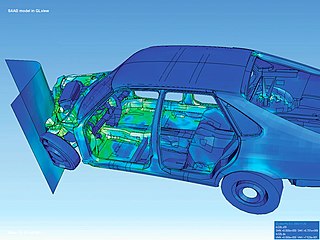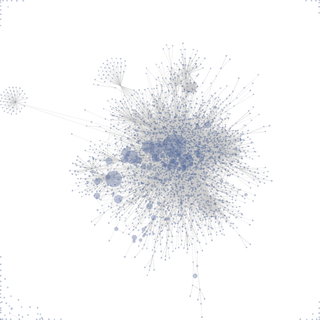Related Research Articles

Visualization, also known as Graphics Visualization, is any technique for creating images, diagrams, or animations to communicate a message. Visualization through visual imagery has been an effective way to communicate both abstract and concrete ideas since the dawn of humanity. from history include cave paintings, Egyptian hieroglyphs, Greek geometry, and Leonardo da Vinci's revolutionary methods of technical drawing for engineering purposes that actively involve scientific requirements.

In scientific visualization and computer graphics, volume rendering is a set of techniques used to display a 2D projection of a 3D discretely sampled data set, typically a 3D scalar field.

Ben Shneiderman is an American computer scientist, a Distinguished University Professor in the University of Maryland Department of Computer Science, which is part of the University of Maryland College of Computer, Mathematical, and Natural Sciences at the University of Maryland, College Park, and the founding director (1983-2000) of the University of Maryland Human-Computer Interaction Lab. He conducted fundamental research in the field of human–computer interaction, developing new ideas, methods, and tools such as the direct manipulation interface, and his eight rules of design.
Stuart K. Card is an American researcher and retired senior research fellow at Xerox PARC. He is considered to be one of the pioneers of applying human factors in human–computer interaction. With Jock D. Mackinlay, George G. Robertson and others he invented a number of information visualization techniques. He holds numerous patents in user interfaces and visual analysis.

Patrick M. Hanrahan is an American computer graphics researcher, the Canon USA Professor of Computer Science and Electrical Engineering in the Computer Graphics Laboratory at Stanford University. His research focuses on rendering algorithms, graphics processing units, as well as scientific illustration and visualization. He has received numerous awards, including the 2019 Turing Award.

Prefuse is a Java-based toolkit for building interactive information visualization applications. It supports a rich set of features for data modeling, visualization and interaction. It provides optimized data structures for tables, graphs, and trees, a host of layout and visual encoding techniques, and support for animation, dynamic queries, integrated search, and database connectivity.
A projection augmented model is an element sometimes employed in virtual reality systems. It consists of a physical three-dimensional model onto which a computer image is projected to create a realistic looking object. Importantly, the physical model is the same geometric shape as the object that the PA model depicts.

Visual analytics is a multidisciplinary science and technology field that emerged from information visualization and scientific visualization. It focuses on how analytical reasoning can be facilitated by interactive visual interfaces.
Jock D. Mackinlay is an American information visualization expert and Vice President of Research and Design at Tableau Software. With Stuart Card, George G. Robertson and others he invented a number of information visualization techniques.

Lawrence Jay Rosenblum is an American mathematician, and Program Director for Graphics and Visualization at the National Science Foundation.
In computing, 3D interaction is a form of human-machine interaction where users are able to move and perform interaction in 3D space. Both human and machine process information where the physical position of elements in the 3D space is relevant.
The Information visualization reference model is an example of a reference model for information visualization, developed by Ed Chi in 1999, under the name of the data state model. Chi showed that the framework successfully modeled a wide array of visualization applications and later showed that the model was functionally equivalent to the data flow model used in existing graphics toolkits such as VTK.
John Thomas Stasko III is a Regents Professor in the School of Interactive Computing in the College of Computing at Georgia Tech, where he joined the faculty in 1989. He also is one of the founding members of the Graphics, Visualization, and Usability (GVU) Center there. Stasko is best known for his extensive research in information visualization and visual analytics, including his earlier work in software visualization and algorithm animation.
Maureen C. Stone is an American computer scientist, specializing in color modeling.

Jean-Daniel Fekete is a French computer scientist.
Visual computing is a generic term for all computer science disciplines dealing with the 3D modeling of graphical requirements, for which extenuates to all disciplines of the Computational Sciences. While this is directly relevant to the software visualistics of Microservices, Visual Computing also includes the specializations of the subfields that are called Computer Graphics, Image Processing, Visualization, Computer Vision, Computational Imaging, Augmented Reality, and Video Processing, upon which extenuates into Design Computation. Visual computing also includes aspects of Pattern Recognition, Human-Computer Interaction, Machine Learning, Robotics, Computer Simulation, Steganography, Security Visualization, Spatial Analysis, Computational Visualistics, and Computational Creativity. The core challenges are the acquisition, processing, analysis and rendering of visual information. Application areas include industrial quality control, medical image processing and visualization, surveying, multimedia systems, virtual heritage, special effects in movies and television, and ultimately computer games, which is central towards the visual models of User Experience Design. Conclusively, this includes the extenuations of large language models (LLM) that are in Generative Artificial Intelligence for developing research around the simulations of scientific instruments in the Computational Sciences. This is especially the case with the research simulations that are between Embodied Agents and Generative Artificial Intelligence that is designed for Visual Computation. Therefore, this field also extenuates into the diversity of scientific requirements that are addressed through the visualized technologies of interconnected research in the Computational Sciences.
Ken Hinckley is an American computer scientist and inventor. He is a senior principal research manager at Microsoft Research. He is known for his research in human-computer interaction, specifically on sensing techniques, pen computing, and cross-device interaction.
Daniel Wigdor is a Canadian computer scientist, entrepreneur, investor, expert witness and author. He is the associate chair of Industrial Relations as well as a professor in the Department of Computer Science at the University of Toronto.
Steven Mark Drucker is an American computer scientist who studies how to help people understand data, and communicate their insights to others. He is a partner at Microsoft Research, where he also serves as the research manager of the VIDA group. Drucker is an affiliate professor at the University of Washington Computer Science and Engineering Department.
Joseph J. LaViola Jr. is an American computer scientist, author, consultant, and academic. He holds the Charles N. Millican Professorship in Computer Science and leads the Interactive Computing Experiences Research Cluster at the University of Central Florida (UCF). He also serves as a consultant at JJL Interface Consultants as well as co-founder of Fluidity Software.
References
- ↑ Keynote Panel Information Visualization - Where are We and Where Do We Go From Here? Proceedings Infovis 1996. Retrieved 6 July 2008.
- 1 2 George G. Robertson (2004). Short bio. Retrieved 6 July 2008.